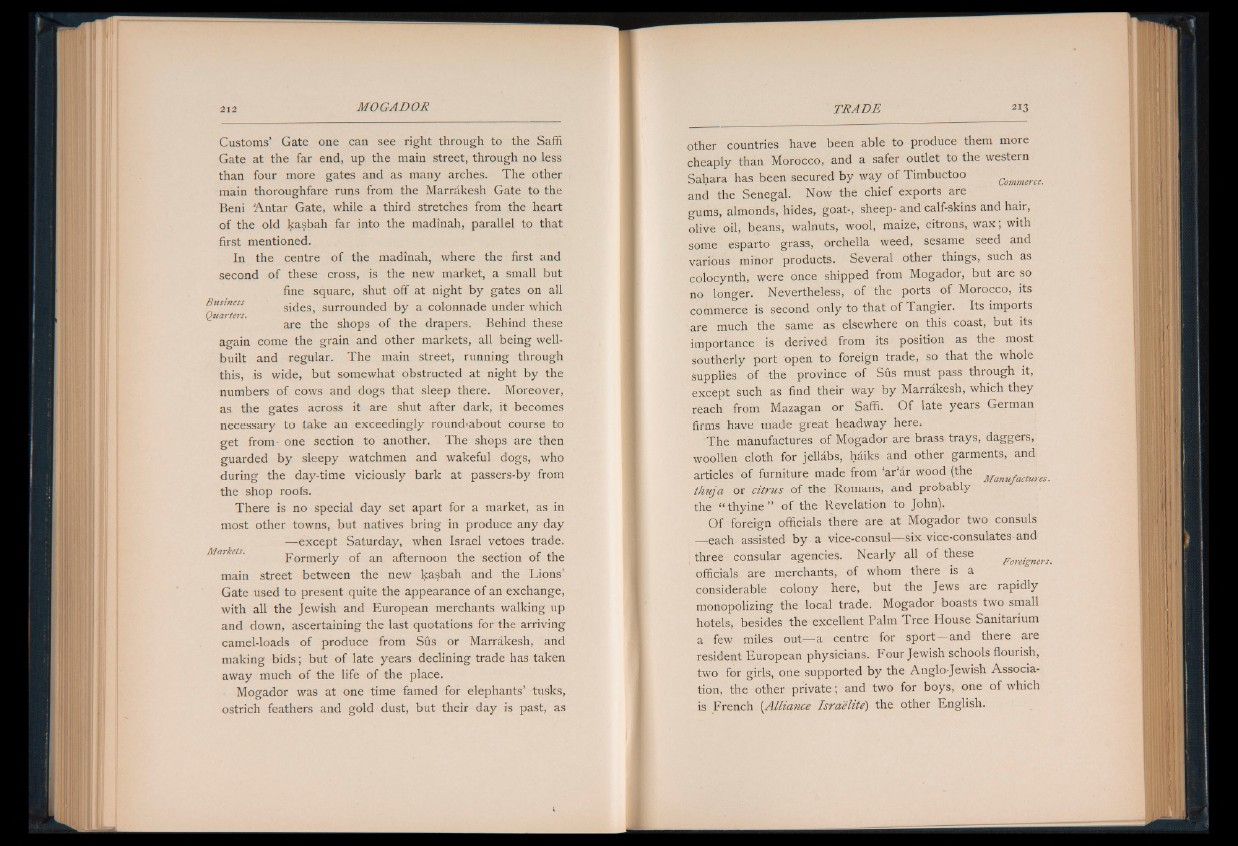
Customs’ Gate one can see right through to the Saffi
Gate at the far end, up the main street, through no less
than four more gates and as many arches. The other
main thoroughfare runs from the Marrakesh Gate to the
Beni 'Antar Gate, while a third stretches from the heart
of the old kasbah far into the madinah, parallel to that
first mentioned.
In the centre of the madinah, where the first and
second o f these cross, is the new market, a small but
fine square, shut off at night by gates on all
sides, surrounded by a colonnade under which
Quarters.
are the shops of the drapers. Behind these
again come the grain and other markets, all being well-
built and regular. The main street, running through
this, is wide, but somewhat obstructed at night by the
numbers o f cows and dogs that sleep there. Moreover,
as the gates across it are shut after dark, it becomes
necessary to take an exceedingly round-about course to
get from one section to another. The shops are then
guarded by sleepy watchmen and wakeful dogs, who
during the day-time viciously bark at passers-by from
the shop roofs.
There is no special day set apart for a market, as in
most other towns, but natives bring in produce any day
/—except Saturday, when Israel vetoes trade.
Formerly of an afternoon the section of the
main street between the new kasbah and the Lions’
Gate used to present quite the appearance o f an exchange,
with all the Jewish and European merchants walking up
and down, ascertaining the last quotations for the arriving
camel-loads of produce from Sus or Marrakesh, and
making bids; but of late years declining trade has taken
away much of the life of the place.
Mogador was at one time famed for elephants’ tusks,
ostrich feathers and gold dust, but their day is past, as
other countries have been able to produce them more
cheaply than Morocco, and a safer outlet to the western
Sahara has been secured by way of Timbuctoo commerce.
and the Senegal. Now the chief exports are
gums, almonds, hides, goat-, sheep- and calf-skins and hair,
olive oil, beans, walnuts, wool, maize, citrons, wax; with
some esparto grass, orchella weed, sesame seed and
various minor products. Several other things, such as
colocynth, were once shipped from Mogador, but are so
no longer. Nevertheless, of the ports of Morocco, its
cotnmerce is second only to that of Tangier. Its imports
are much the same as elsewhere on this coast, but its
importance is derived from its position as the most
southerly port open to foreign trade, so that the whole
Supplies of the province of Sûs must pass through it,
except such as find their way by Marrakesh, which they
reach from Mazagan or Saffi. Of late years German
firms have made great headway here.
The manufactures of Mogador are brass trays, daggers,
woollen cloth for jellâbs, hâiks and other garments, and
articles of furniture made from ‘ar‘ar wood (the Manufactures_
thuja or citrus of the Romans, and probably
the “ thyine ” of the Revelation to John).
Of foreign officials there are at Mogador two consuls
—.each assisted by a vice-consul— six vice-consulates and
; three consular agencies. Nearly all of these Foreigners.
officials are merchants, of whom there is a
considerable colony here, but the Jews are rapidly
monopolizing the local trade. Mogador boasts two small
hotels, besides the excellent Palm Tree House Sanitarium
a few miles out— a centre for sport and there are
resident European physicians. Four Jewish schools flourish,
two for girls, one supported by the Anglo-Jewish Association,
the other private ; and two for boys, one of which
is French (Alliance Israélite) the other English.